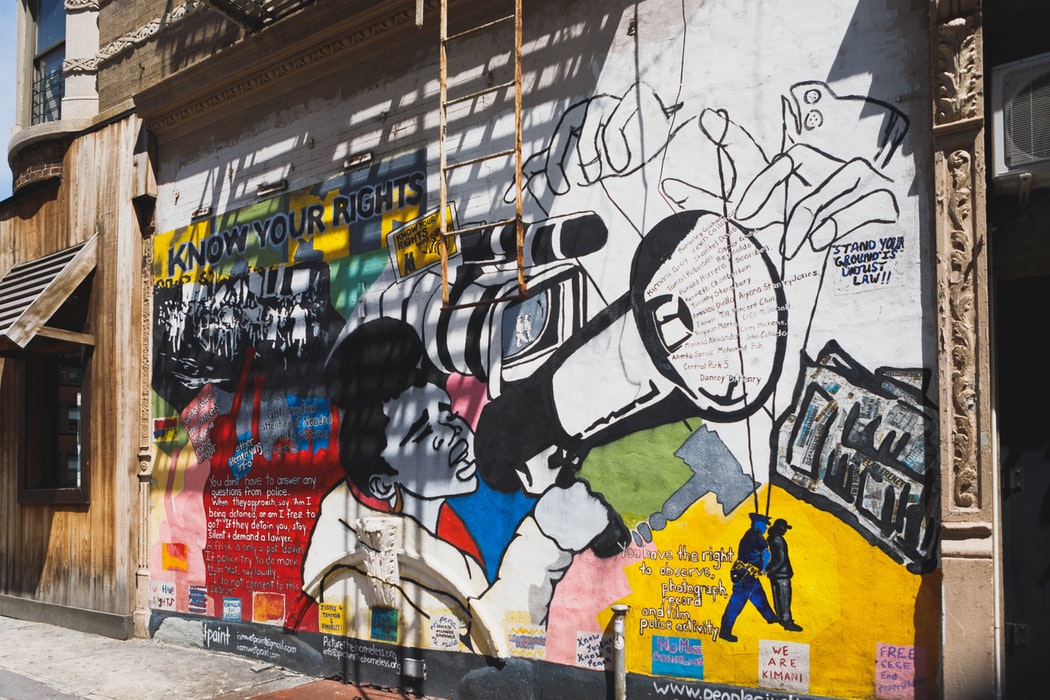The Harlem Renaissance was a literary movement that developed in New York during the 1920s. It focuses on the development of art and literature as a form of positive representation for black African Americans.
Stylistics Presentation
Attached is a group presentation focusing on the module of Stylistics, by exploring an extract of ‘Kafka on the Shore’ through the analysis of 2 different stylistic theories.
Written plan of the curation of my own art exhibition/event
Introduction:
As the Head Technician and Curator for Coventry University’s Faculty of Arts and Humanities, I take responsibility for the creative planning and safe delivery of 12 students artwork to showcase in a 1920’s Jazz Age themed exhibition at ‘The Old Truman Brewery’, located in the heart of Brick Lane in East London. The exhibition will showcase a variety of art forms including projection, sculptures, paintings and photography. Upon acceptance of my proposal, my team and I must ensure the exhibition is conducted in a professional manner whilst maintaining a creative atmosphere the venue is accustomed to.
Pre-exhibition:
To ensure the development of the exhibition is proficient, all preparations will begin three weeks prior to the opening date. First, I will ensure that all the featured artists have delivered their artwork along with their relevant display instructions. Once I have received the work, I will observe the condition for each piece and undergo the initial condition reports to document any damages at regular intervals. Two weeks prior, I will visit the venue to finalise the exhibition layout and liaise with the technical team regarding any potential challenges effecting the opening night and the space as a whole. I will also liaise evacuation routes with the fire chief and hand over a list of artwork to prioritise in the event of a fire. When developing the final exhibition layout, I must consider the flow of people and their movement around the space taking the health and safety of the public and staff working the exhibit, into consideration.
Insurance and licensing:
Particular warehouse units in the venue are already covered under particular licensing acts. I will be using the first floor T1-T5 units and private studio therefore would need to obtain a Premises License to sell alcohol as part of my exhibition theme. Under The Copyright, Design and Patents Act 1988, I will also need to obtain a music license from the PPL and PRS as I plan to play typical 1920s Jazz music throughout the exhibition. Considering my space will be open to the public I will need Public Liability Insurance to protect the welfare of my audience as well as Art Insurance to protect the work displayed.
Marketing:
Marketing is a crucial component for the success of any event or exhibition. I will incorporate the core elemental 1920s consumerist value of ‘needing rather than just wanting’, by promoting the exhibition as being a needed experience. I plan to send out twenty personalised invitations to a selection of contacts alongside reminder emails to a larger potential audience. Social media is a vital and growing marketing strategy, therefore I will create a Facebook Events Page and an Instagram account where audiences can follow the progress of the exhibition as well as using the venue’s website as a platform to promote.
Travelling to exhibition/packaging:
I aim to transport the work to London a week prior to the
exhibition. I will contact the venue beforehand to ensure that there is
suitable loading bay access area nearby, to minimise the damage of the work
when unloading into the building. I have requested the units T1-T5 to be kept
empty and I will unload the work into these spaces to allow a reasonable time
to set up the space whilst reducing any damage from excessive movement in the
venue. Whilst packaging the work, a second condition report will be conducted
to aid post-transport analysis.
During the packaging process all the handlers will wear white cotton gloves to prevent fingerprint marks and the transfer of oils onto the work. Transit is an unstable environment for artwork and as curator I must ensure each piece is packaged safely according to the art type. I will backboard the paintings to absorb any shock from travelling and insert them in a slate crate, alongside the photographs, to keep each varied sized piece from touching. The projector will travel in a flight case to protect it. The illustrations on delicate paper will be rolled into tubes with acid-free tissue paper protecting each side to avoid any ferrotyping. The sculptures will be put into crates with engine foam to keep them in place and avoid any damages to their shape. The design product will also be put into a crate and by shrink-wrapping these crates; the work will be further protected from any temperature and moisture changes. To ensure the van is temperature and humidity controlled, I will use a digital hygrometer to measure humidity levels and a thermohygrometer (fig 1.) to get a combined temperature reading. All the artwork will be strapped to the van to reduce movement and I will use shockwatches to measure any excessive impact to the artwork during transit.
Arrival at exhibition space:
Upon arrival of the exhibition space, the van will park in the loading bay of ‘Elys Yard’ car park where there are multiple entrances into the space through T1, 2, 3 and 4 unit doors. This variety of access points allows efficient unloading as multiple works can be moved into the space at a single time.
During the unloading process, health and safety of the handlers and the artwork is imperative hence I will consistently use the ‘calculation of 3’ to assess all potential risks. All the handlers will wear protective clothing including steel capped boots, when moving the work and white cotton gloves when handling the art. All the relevant tools required must be thoroughly inspected beforehand to ensure they are in working condition. The pieces will be moved through the entrances on a wheeled trolley to prevent the work being dropped and any injuries to the handlers. During the set up I will check the humidity levels of the exhibition space and install hygrometers to continuously monitor and control the environment. I will also conduct PAT tests on all the electrical equipment to make sure they meet the relevant standards. Upon unpacking the work, I will check the shockwatches to monitor any damaging impact caused from transit. This information will be recorded in the third condition report once the work is unpacked after transit.
Layout and Installation:
The exhibition layout is heavily influenced by the artists’ preference in the way their work should be displayed. To prevent disturbance during the set up of the exhibition, the space will be emptied and blocked off and all the staff working on the exhibition will be PASMA trained to fulfil health and safety standards.
Lighting is a key aspect in my exhibition theme and by using a lux meter I will be able to measure the light levels. The natural light from the windows and doors will need to be blacked-out to create a dimly lit speakeasy atmosphere. Florescent tube lights inspired by Dan Flavin (fig. 2) will frame the illustrations and the design product will be isolated, spotlighted by a single standalone lamp. The six small sculptures will be standing on plinths with removable lids to use the hollow insides as extra storage space. Ryman hangers will be used to hang the larger paintings, however, fine tailoring pins will be used to hand the smaller paintings and photographs, both fixing types are discreet and secure. When ensuring the paintings are hung at eye level I will use a laser level whilst the photographs will be hung at different levels therefore I must ensure that all the invisible lines are corresponding for aesthetic appeal. The large sculpture will be suspended from the ceiling and therefore my team and I will need to hire a Mobile Elevated Work Platform (MEWP). Finally, since there is no allocated space for the projection, I will build a corridor using false walls that will be dark enough for the projection to be visible.
Opening Night:
The exhibition will run for approximately two weeks with an opening night. On the opening night, there will be refreshments located in the private studio to avoid the interruption of the exhibition’s atmosphere, here the audience will be given complimentary champagne displayed on a rotating champagne tower carousel. I will also serve fish based oeuvres and mixed nuts, popular items on speakeasy menus in the 1920s. The use of a large space is beneficial with an expectation of a large audience, as their movement will be directed efficiently whilst ensuring their safety. In addition, throughout the running of the exhibition, all the gallery attendants will be equipped with my contact details, on the chance that audience members wish to get into contact with me.
Post-exhibition:
The morning after the final night, my team and I will be responsible for the swift and professional de-installation of the exhibition with the teams health and safety at the forefront. When packaging the work for transit, another condition report will be conducted to record any damages that might have occurred during the event. The holes drilled into the walls will be filled in and the venue restored to the condition we received it in. Once the artwork has been repackaged and stored into the van, I will have a debriefing with my team to discuss the successes, particularly around the theme and the challenges of the event and improvements for future events, this feedback will be reported to funders.
Bibliography:
B&Q (2017) ‘How to build a stud wall’. in Youtube [online] available from < https://www.youtube.com/watch?v=hJlz1L_cYgU> [24 November 2019]
Dean, L. (2019) Art Works on the Move [online lecture] module A204DVA. 7 October 2019. Coventry: Coventry University. available from < https://cumoodle.coventry.ac.uk/pluginfile.php/3070256/mod_resource/content/1/3%20wk%203_packaging%20%20moving%20%20handling%20%20storing.pdf> [23 November 2019]
Dean, L. (2019) Health and Safety [online lecture] module A204DVA, 28 November 2019. Coventry: Coventry University. available from <https://cumoodle.coventry.ac.uk/pluginfile.php/3105391/mod_resource/content/1/6%20wk%206_health%20and%20safety.pdf> [24 November 2019]
Dean, L. (2019) Plinths [online lecture] module A204DVA, 11November 2019. Coventry: Coventry University. available from < https://cumoodle.coventry.ac.uk/pluginfile.php/3117533/mod_resource/content/2/8%20wk%208%20assignment%20launch_plinths_lightboxes.pdf>
Gov.uk (2018) Guidance Alcohol Licensing [online] available from < https://www.gov.uk/guidance/alcohol-licensing>
Guggenheim (2019) Dan Flavin: The Architecture of Light
available from <https://www.guggenheim.org/exhibition/dan-flavin-the-architecture-of-light>
The Old Truman Building (2012) The Old Truman Building [online] available from <http://trumanbrewery.com/cgi-bin/index.pl>
The Old Truman Building (2012) F First Floor (T1-T5) Exhibitions [online] available from <https://trumanbrewery.com/cgi-bin/venue2.pl?sub=&rID=3249>
PPL PRS (2019) Do I need a music license? [online] available from <https://pplprs.co.uk/do-i-need-a-licence/?utm_source=pplwebsite&utm_medium=pws&utm_campaign=BAU_ppl&utm_content=PlayMusicPara1TML>
Figures: (see floorplan post)
Figure 1: Example of a Thermohygrometer
Figure 2: Dan Flavin Artwork on Lighting Architecture
Figure 3: Gallery layout from ‘The Old Truman Brewery’
Figure 4: Exhibition layout floor plan
How employable do your skills make you?
‘Professional Development’ outlined the value of employability skills and their relevance to establishing a career. Employability skills are classified as “general job skills” which are “common skills needed to do most jobs” (Youth Central: 2017). Through different employability training within and prior to the module, I have developed and enhanced practical skills that can be further developed in the future.
Within the module I have enhanced my problem solving skills through a mock group interview activity. Each member of the group represented a different department of a company and the activity required us to divide a budget between these departments, each pitching for a certain amount. As a collective we had to decide the best way to divide the money. By evaluating the benefits of each department to the company and the effects of receiving their desired budget we were able to compromise a suitable budget between each department that would ultimately benefit the company as a whole.
Another key employability skill I developed during the module was my listening and communication skills. Throughout the module we had a variety of guest speakers informing us about the different post-graduate routes, benefits of internships and different schemes available to help develop our CVs. By attending these guest speaker events, I was expected to engage with the speakers and their open-floor discussions whilst simultaneously listening to their presentations to understand the advantages and disadvantages of their career opportunities.
It is essential that employers have evidence of an individual’s capacity and skills, commonly demonstrated through their experiences (Trought 2017). Whilst developing skills on the module, I have also gained employability skills through different experiences.
During Sixth Form, I was part of our Student Leadership Team as the Events Manager where my role consisted of organizing and overseeing all the major events including fundraisers for Children in Need, Grenfell Tower and Breast Cancer as well as our annual Student Theatrical Design Art Show, enhancing my leadership skills. My role required me to frequently liaise with the other members on the team to ensure the delegated tasks were being completed to meet crucial deadlines, improving my time management skills. I also assisted the finance team, which improved my overall budgeting and money handling skills as well as leading the marketing for these events by creating flyers and speaking in assemblies. Being on the forefront of the marketing developed my public speaking skills as well as introduced me to learning new computer software skills such as Adobe Photoshop.
As well as taking up leadership roles, being part of the Musical Theatre Society (MTS) at University has allowed me to develop these general skills. Being a society member requires the characteristic of being “open to try new things” (Youth Central: 2017), and to part-take in activities outside of your own comfort zone. By learning new dances I surpassed my comfort zone to work in a collective team and ultimately improve my self-confidence, an integral aspect associated with public speaking presentation skills. This is reflected in throughout my degree where I am expected to give assignments in the form of presentations and due to the skills developed in MTS, I am able to successfully deliver these presentations.
Another experience where I am able to develop my skills set is through my job as a personal tutor. Self-management is defined as the “readiness to accept responsibility” (Trought 2017) and as a tutor, my self-management skills have been integral to ensure that all lessons are effective for the student to understand the content. I have to remain organized with marking and feedback to ensure that any teaching improvements can be made within a suitable timeframe. Being a tutor, requires working towards a deadline, the student’s exams, and therefore I have to be able to adapt my teaching techniques to the their preferred learning style within short periods of time. My ability to adapt is an integral skill required in the workplace as it aids problem solving as well as other skills and how they can be applied in a variety of situations.
In conclusion, I have been able to develop new and existing
employability skills throughout different experiences both within and outside
of the module. Although these experiences range differently from each other,
the skills developed are transferrable and can all be used effectively in the
workplace when shaping my future career.
References (2):
Trought, F. (2017) Brilliant Employability Skills: How to stand out from the crowd in the graduate job market. [Coventry University e-brary] Harlow: Pearsons. available from <https://bibliu.com/app/#/view/books/9781292158921/epub/OPS/html/chapter-001.html#page_19>
Youth Central (2017) Job skills you should have [online] available from <https://www.youthcentral.vic.gov.au/jobs-and-careers/plan-your-career/8-job-skills-you-should-have>
Post-graduation and the routes you didn’t know about
The module of ‘Professional Development’ has provided me with the opportunity to understand the importance of preparing for post-graduation as well as broadening my understanding of the options available for an English graduate. In this post I will be exploring the options available as well as my potential career plans for after graduation.
An English degree can provide a “wide variety of job opportunities” (The World University Rankings: 2019) at post-graduation. One of the most common career choices is primary and secondary school teaching; the module expanded my knowledge regarding the Post-graduate Certificate in Education (PGCE), “an academic qualification that you can achieve during your teacher training” (Department of Education: n.d). However after gaining tutoring experience, I feel that teaching a larger quantity of students at a single time would be too challenging and therefore I would prefer to follow a different career choice whilst continuing to tutor separately.
Aside from the common career choice of teaching, the module has introduced me to the idea of internships and employability options stemmed from summer placements. After having a careers meeting with the University’s FAH careers department, I was introduced to various websites and forums where I can apply for placements. One of the advantages of doing a placement year is the invaluable experience and potential contacts made, relevant for post-graduate employability. Another advantage of a placement is the ability to understand what career path I would want to pursue, it will enable me to experience a potential career path and decide whether I want to continue on a particular career option. Websites such as indeed.com and fashionworkie are two popular platforms English undergraduates can use to research and apply for placements in industries such as marketing, digital media, communications, fashion and theatre. I have used indeed.com to explore marketing and digital media internships; this has allowed me to enhance my CV and practice tailoring it to specific companies and their job roles.
Although immediate employment is the expected career choice, there are options for further education after doing an undergraduate degree. During the module, university lecturers came to discuss the possibility of pursing a Master’s Degree in English Literature at Coventry University. Although a Masters qualification can “greatly improve your career prospects” it is also “academically demanding” and requires thorough research (prospects: 2019). The Masters consisted of various modules such as creative writing, applied linguistics and literature and the environment. Each of these modules has links to potential career options and the potential skills developed from the post-graduate qualification were able to be applied into future employability sectors, exemplary through the creative writing module where students went onto writing and publishing their own books, journals and screenplays. The MA also links to teaching programs with a MA ELTAL TESOL pathway, a qualification where students can further their higher education and eventually go onto teaching at degree level.
Despite the wide range of post-graduate options introduced on the module, I have been considering going into law as a career option. After taking ‘Law in Action-legal knowledge and res skills for non-lawyers’ as my add-vantage module in first year, I developed an interest in corporate law and therefore after researching potential routes into law, I learnt about the Graduate Diploma in Law (GDL). The GDL is “conversion course” designed to “provide non-law graduates with a diploma equivalent to a law degree” which eventually enables entry into the professions of a barrister or solicitor (LawCareers: 2019). I have chosen to pursue a career in law, as it is an integral part of our economically expanding society and therefore I believe it would be a stable and unchanging career. The decision to pursue a law career means having to further research potential GDL courses as well as undergo my own research around the subject and the type of law I would like to follow. In my add-vantage, I was introduced to corporate and contract law, which I found quite interesting, as I was able to develop skills in drafting my own legally binding contract and learnt to understand the features of an official contract. My primary steps would be to start applying for summer internships in corporate law firms, working alongside solicitors to help me understand how the job role works and to affirm my interest in the subject and its possibilities of being a potential career pathway. To successfully get into an law internship I need to tailor my CV specifically for law firms and the job types they advertise as well as modifying my experience sections to highlight relevant skills used and valued in law settings. Secondary steps in pursuing this career choice would consist of researching the details of the GDL and eventually applying for courses during the start of my final year to ensure it does not clash with the time allocated for writing my dissertation.
Overall, I feel the module has broadened my
knowledge on the options available for English graduates. Whilst expanding on
popular and commonly known post-graduation options, it has also introduced me
to new opportunities and allowed me to make decisions for my potential career.
References (1):
Department of Education (n.d.) Get into Teaching [online] available from <https://getintoteaching.education.gov.uk/explore-my-options/teacher-training-routes/pgce>
Fashionwokie (2019) Listings [online] available from <https://www.fashionworkie.com/listing-search?search_api_views_fulltext=internships>
Indeed (2019) Job Search [online] available from <https://www.indeed.co.uk/jobs?q=marketting&l=London%2C+Greater+London>
LawCareers (2019) GDL [online] available from <https://www.lawcareers.net/Courses/GDL>
Prospects (2019) Post-graduate study; Masters degree [online] available from <https://www.prospects.ac.uk/postgraduate-study/masters-degrees/what-is-a-masters-degree>
The World University Rankings (2019) What can you do with an English Language Degree? [online] available from <https://www.timeshighereducation.com/student/subjects/what-can-you-do-english-language-degree>





